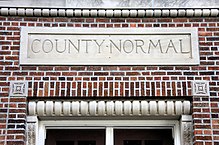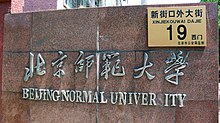
Back دار المعلمين الابتدائية Arabic নর্মাল স্কুল Bengali/Bangla Escola Normal Catalan Coleg normal Welsh Normalschule German Escuela normal Spanish Normaalikoulu Finnish École normale French Normaalskoalle Frisian नौर्मल स्कूल Hindi
This article has multiple issues. Please help improve it or discuss these issues on the talk page. (Learn how and when to remove these messages)
|


A normal school or normal college is an institution created to train teachers by educating them in the norms of pedagogy and curriculum. Many such schools have since been called teacher training colleges or teachers' colleges, but in Argentina and Mexico they continue to be called normal schools with student-teachers in the latter country being known as normalistas.[1] Many schools require a high school diploma for entry, and may be part of a comprehensive university. Normal schools in the United States, Canada, and Argentina trained teachers for primary schools, while in Europe, the equivalent colleges typically educated teachers for primary schools and later extended their curricula to also cover secondary schools.
In 1685, St. Jean-Baptiste de La Salle established the Institute of the Brothers of the Christian Schools, founded what is generally considered the first normal school, the École normale, in Reims, Champagne, France. The term "normal" in this context refers to the goal of these institutions to instill and reinforce particular norms within students. "Norms" included historical behavioral norms of the time, as well as norms that reinforced targeted societal values, ideologies and dominant narratives in the form of curriculum.
The first public normal school in the United States was founded in Concord, Vermont by Samuel Read Hall in 1823 to train teachers. In 1839, the first state-supported normal school was established by the Commonwealth of Massachusetts on the northeast corner of the historic Lexington Battle Green; it evolved into Framingham State University. The first modern teacher training school in China was established by educator Sheng Xuanhuai in 1895 as the normal school of the Nanyang Public School (now Shanghai Jiao Tong University) in Shanghai during the Qing dynasty.[2]
Many comprehensive public or state-supported universities—such as UCLA[3] in the United States and Beijing Normal University in China—were established and operated as normal schools before they expanded their faculties and transformed themselves into research universities. Some of these universities, particularly in Asia, retain the word "Normal" in their name to highlight their historical purpose. In Canada, most normal schools were eventually assimilated into a university as its faculty of education, offering a one or two-year Bachelor of Education degree. Such a degree requires at least three, but usually four, years of prior undergraduate study.
- ^ Padilla, Tanalís. "'Latent Sites of Agitation': Normalistas Rurales and Chihuahua's Agrarian Struggle in the 1960s". In México Beyond 1968. Tucson: University of Arizona Press 2018
- ^ Yu, Tingjie. "Teacher Education in China : Current Situation & Related Issues" (PDF). uta.fi. Institute of Education Sciences, Zhejiang Normal University. Archived from the original (PDF) on 2018-11-30.
- ^ "How UCLA Came To Be". newsletter.alumni.ucla.edu. Retrieved 2023-03-02.